I cannot bottle late December joy, but I can make marmalade
my first adventure in marmalade making
Welcome to The Apéritif! Thank you for reading. If you haven’t already, you can subscribe using the button below to receive more vegan recipes and other food-related thoughts.
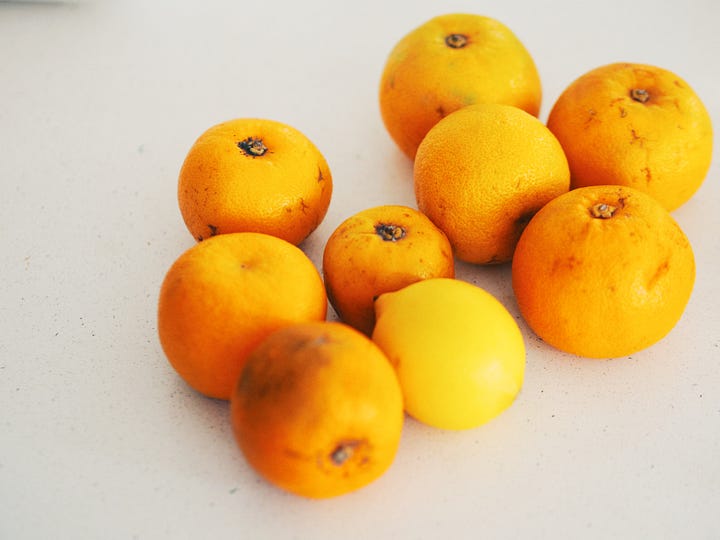
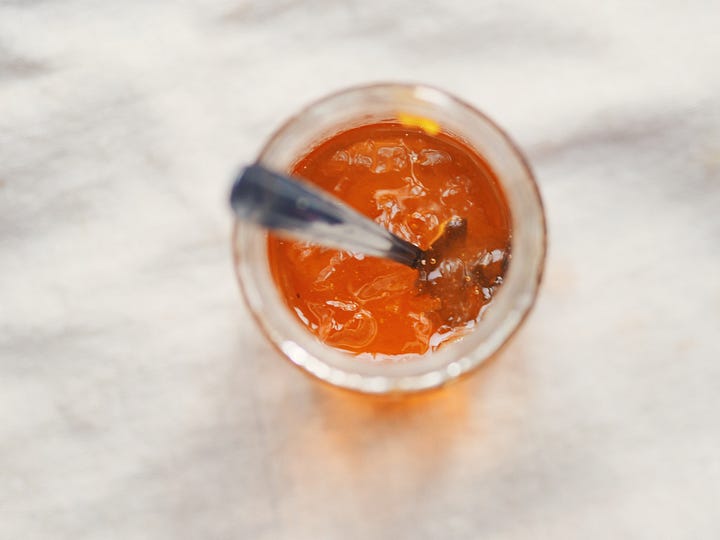
The oranges arrived the day after we got home. The mist had been thick the whole way back, as it had been for several days over Christmas in the south-west of England. It was eerie, atmospheric, especially along dark country roads — bare trees clawing up out of the mist and reaching for the sky, the warm glow of Christmas lights in passing houses visible but shrouded by the thick grey veil.
It was still grey a few days later when, on the penultimate day of the year, the time I had appointed for marmalade making arrived. I’m not sure I could have told you what day of the week it was (that week between Christmas and New Year is a sacred time warp, cut off and protected from the icy hands of the clock which govern our lives the other 51 weeks of the year) but only that I had decided it was to be marmalade day.
Seville oranges have quite a short season, running only from the end of December to mid February at the latest, so that is the marmalade-making window for the year. And of that short season, I wanted to take advantage of being home to use my parents’ kitchen which is larger than mine, in a period of time where I wouldn’t feel rushed.
The recipe isn’t my own — having never made marmalade before, I followed Delia Smith’s recipe as set out here, with a few exceptions which I’ll come to. I looked at quite a few different recipes before I got started and they were all quite similar: 1kg of Seville oranges, 1 lemon, 2kg of sugar.
In hindsight I should have started earlier in the day — it was almost noon by the time I began the first step of juicing the 1kg of Seville oranges and a lemon. But days should not be rushed in that season, that is our Faustian pact with capitalism: 51 weeks shalt thou labour, but the 52nd belongs to you, if you have that privilege. I wanted my sleep, my coffee by the Christmas tree, my quiet morning in red checked flannel pyjamas.
The first step of juicing takes time, but not as long as the second: separating the flesh, pips and pith from the peel of the oranges. (And also the lemon, in my case - Delia only uses the juice of the lemon, and leaves it up to you whether you also include the peel, pith and pips of it along with the oranges. I opted to include everything, because why not.) That is a job. I found a grapefruit knife to be the best tool for that, but it does take an age.
That said, one thing I do appreciate a lot about the process is that every single part of the orange is used in some way. The juice and the chopped, de-pithed peel goes into the pan itself, then the pith and pips go in a muslin bag (I used the one that my Christmas pudding came wrapped in, after a wash — a good idea from my mum) sealed up well and placed in the centre of the pan, because you want all the pectin they contain but not the pith and pips themselves.
It made me reflect on the importance of food preservation for so much of human history, and the amount of energy that went into it. You used everything, you preserved as much as you could, because when the season passed it was gone for that year. In our era of food security, imported food, and home refridgeration, it is almost incomprehensible how much labour went into ensuring there would be food all year round.
For all that I am not a patient person (it is indeed a virtue, but not one that I possess in any quantity to speak of), I had set aside a whole day for marmalade making, and once I accepted that it really was going to take that long to make 10 jars of maramalade, I settled into the task a little. When you’re so used to a high-paced, cortisol-fueled life, it is sometimes nice simply to put on some classical music, accept that you will be de-pithing oranges for the foreseeable, and let your nervous system relax into concentrating on the manual task at hand. Up to a point, anyway — I enventually got so bored of that particular task I roped in my brother to do the rest.
Once every part of each orange has been thoroughly removed from every other part of each orange, multiplied by a kilo of oranges, the cooking itself can actually begin. The pot of juice and peel, with the muslin bag full of pith and pips sat in the centre, simmers for about two hours.
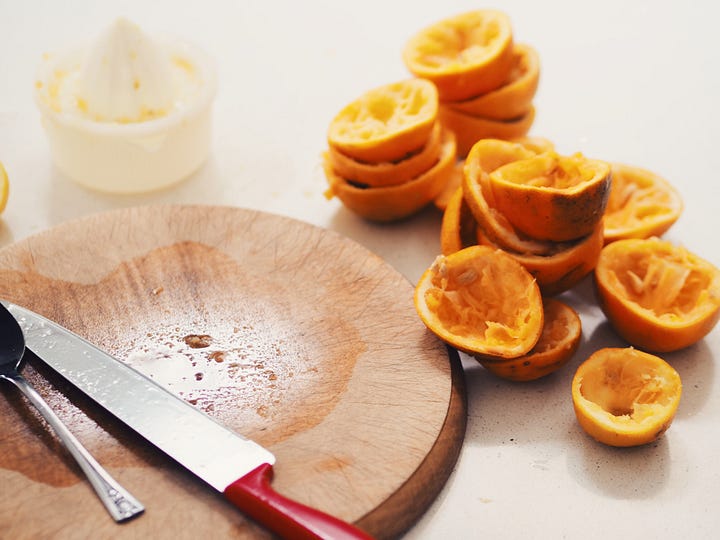
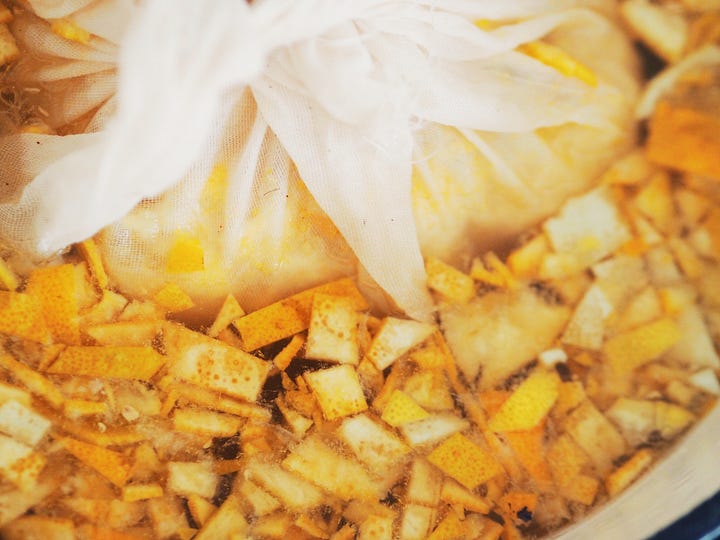

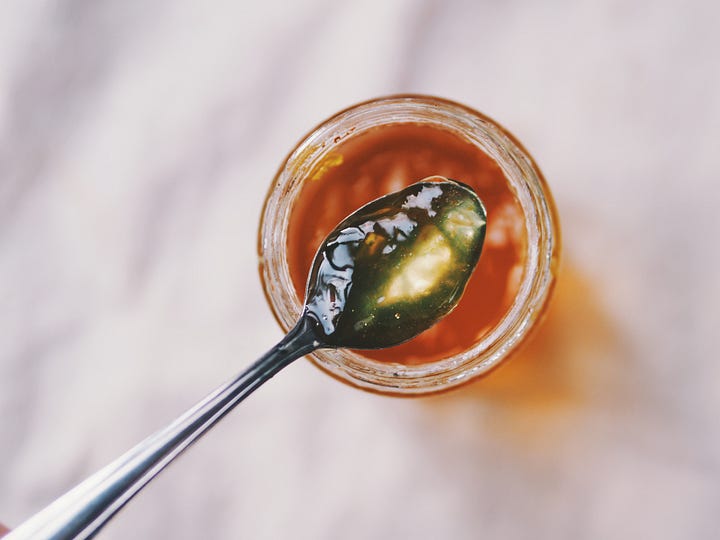
Once two hours has passed, you remove the muslin bag and add the 2 kilos of sugar. I used regular granulated sugar here - Delia and some other recipes call for preserving sugar, but I read others that say it isn’t necessary, and for me it worked fine with regular granulated sugar. The sugar needs to dissolve completely, then you want to squeeze the pectin out of the muslin bag into the pot, and do a final fast simmer for 15-20 minutes before testing to see if it’s set. This is also the time to sterilise the jars, and here I followed my mum’s method rather than Delia’s: having soaked them in a large bowl of hot soapy water along with their lids, I put the dried jars in the oven for 20 minutes at 130 degrees C, on an oven tray on a layer of newspaper, taking them out only when the marmalade was ready to be poured into them with a funnel.
The grey light had faded away to deep darkness by the time I finally poured the hot marmalade into jars, and I questioned whether it had really been worth the time, for all that the marmalade really does taste good. I returned to my pyjamas and general lounging.
But now, as the warm lights of Christmas fade, the time warp has spat me out, and the clocks tick anew. As the return to work and the ice cold water of reality looms, the grim reaper of capitalism waits on the threshold to wring another year of labour from me. It is a rough time of year, early January. There is still much beauty in wintertime — snow and pine and candles and hot chocolate and warm blankets are not the preserve of the festive season — but there is no denying it is rough. Here, now, back in Paris in -3 degrees, I am glad of my marmalade. I am glad of warm, toasted fresh bread and the bitterness of bright, bold, sunny Seville oranges. I am glad to think of my parents eating it on their own toast at the weekends, 200 miles away.

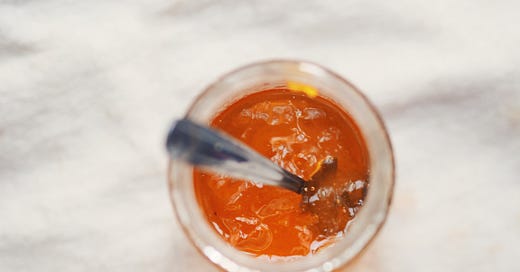



There is something beautiful about citrus in the winter and you described it so perfectly ✨I had no idea marmalade was so time consuming!
Very enjoyable read. You captured the feelings involved beautifully, I’m inspired to make some of my own ✨